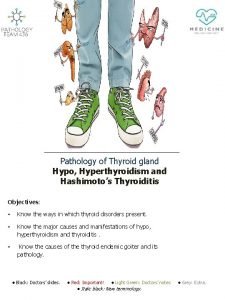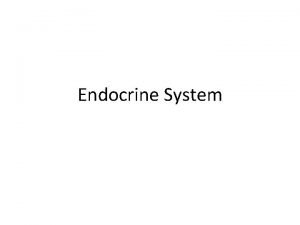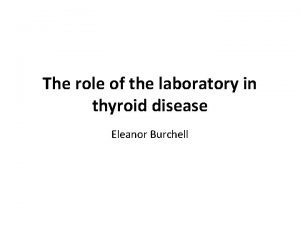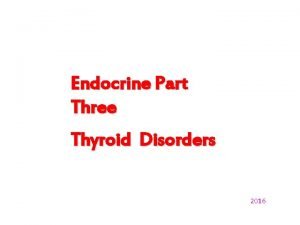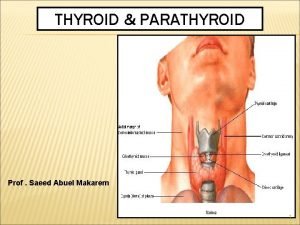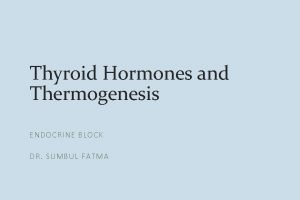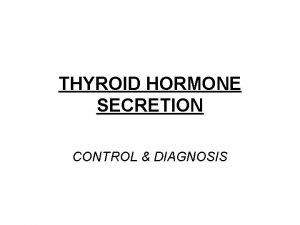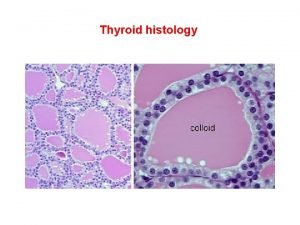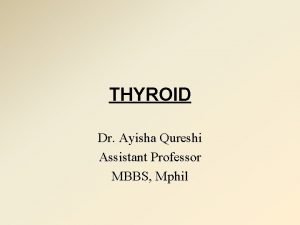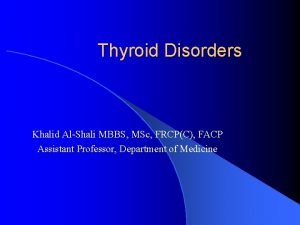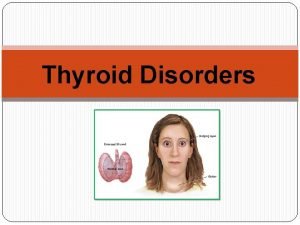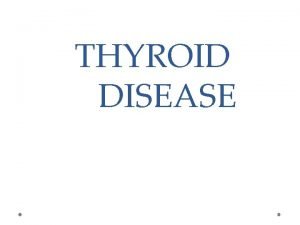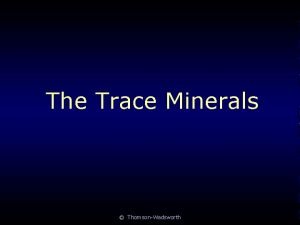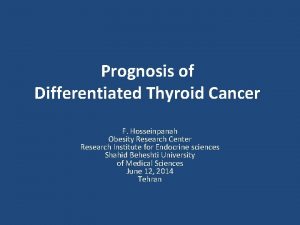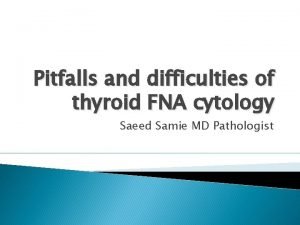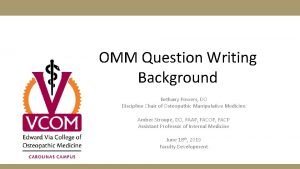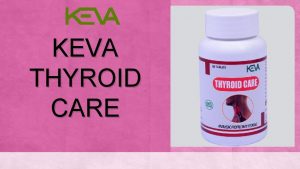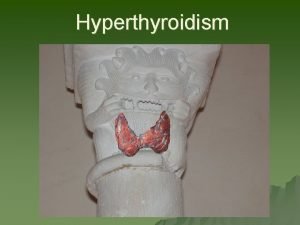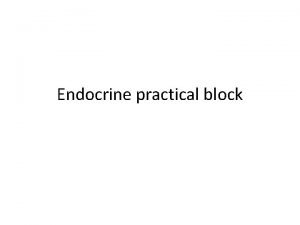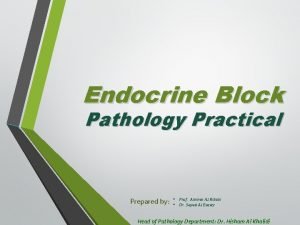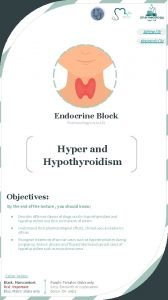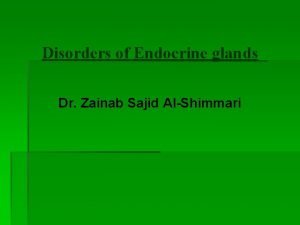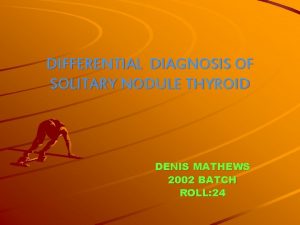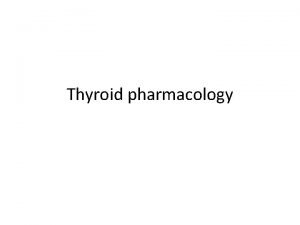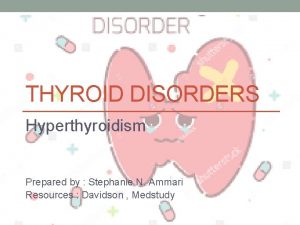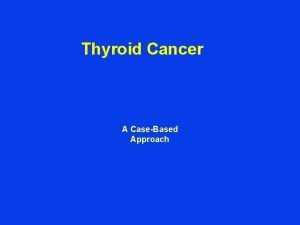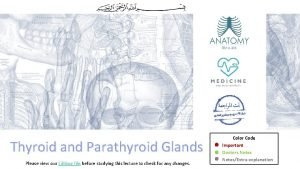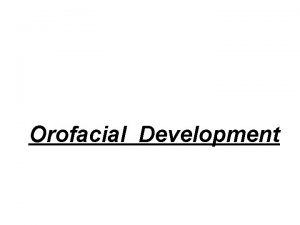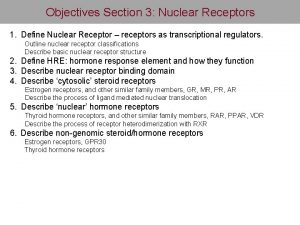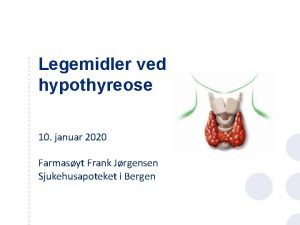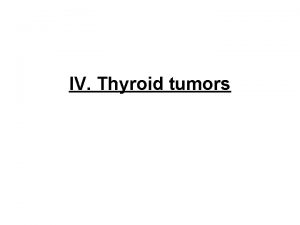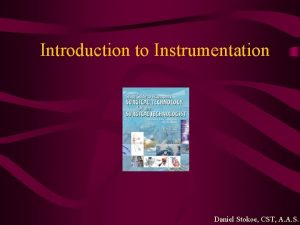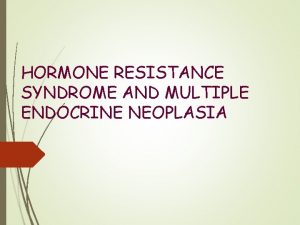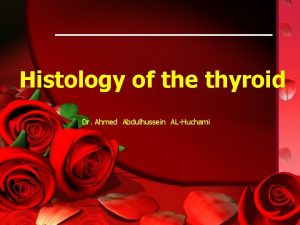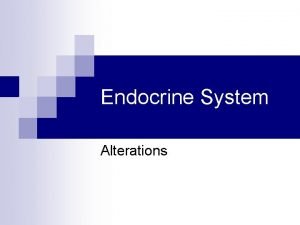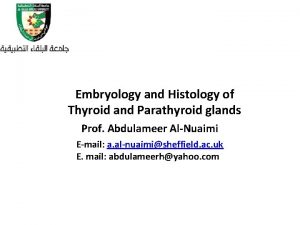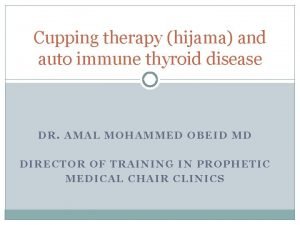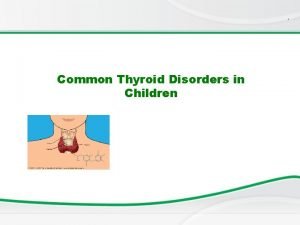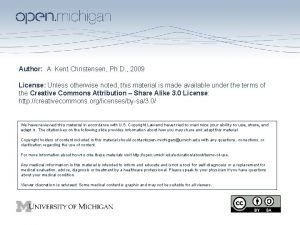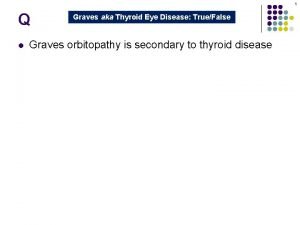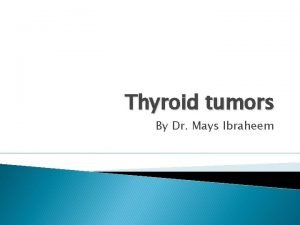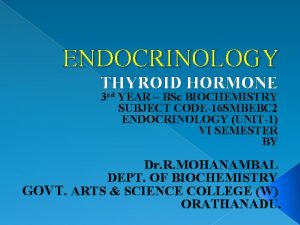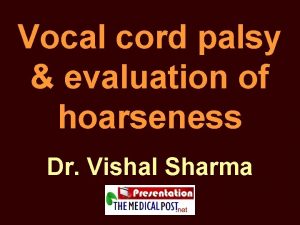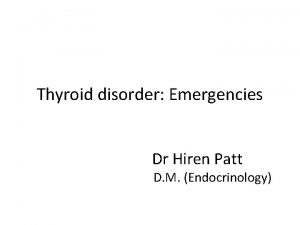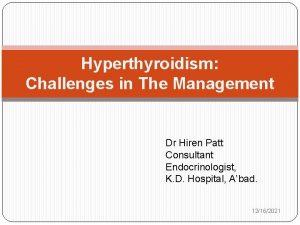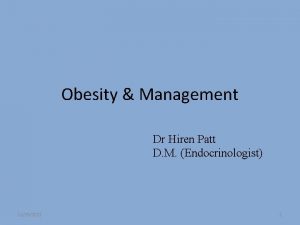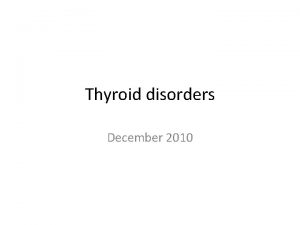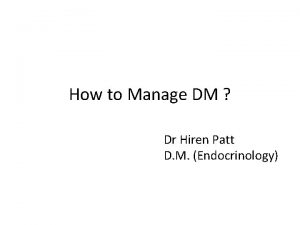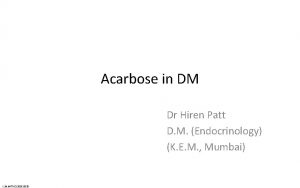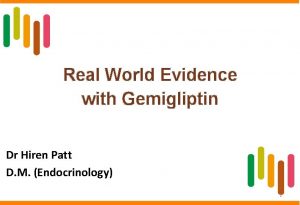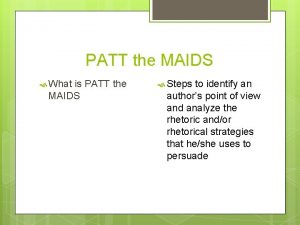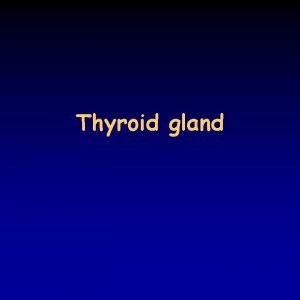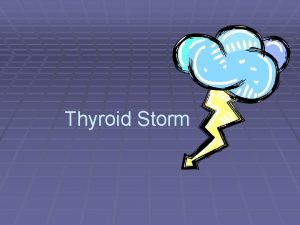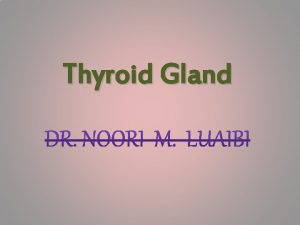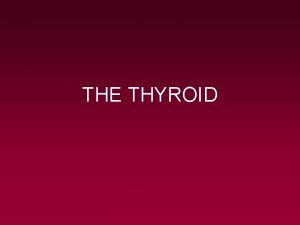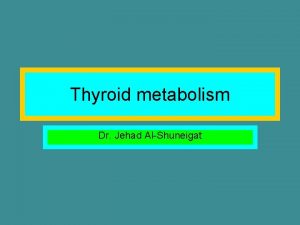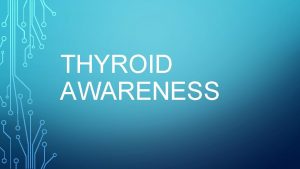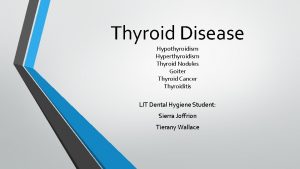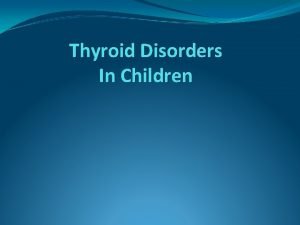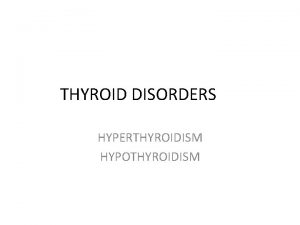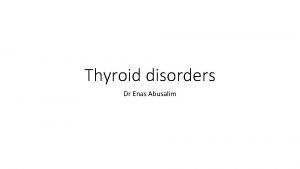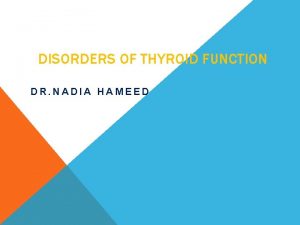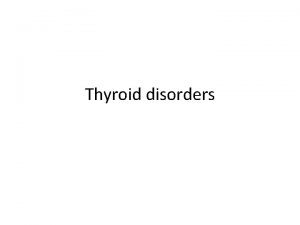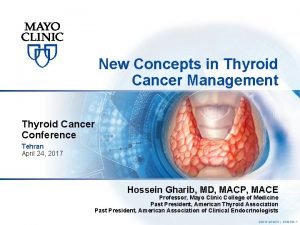Thyroid Disorders Management Issues Dr Hiren Patt D

























































- Slides: 57

Thyroid Disorders: Management Issues - Dr. Hiren Patt D. M. (Endocrinology) (K. E. M. , Mumbai)

Management Issues • T 4 dose titration: how & when ? • Subclinical Hypothyroidism: When to treat ? • Thyroid disorders in Pregnancy: how to manage ?

T 4 Dose Titration

Factors Affecting • Age • Weight • Lean body mass • TSH/Free T 4 • Pregnancy/OCP: increase 30 % • Etiology of hypothyroidism Total thyroidectomy (2 – 2. 5 mcg/kg/day) > AITD (1. 6 – 1. 7 mcg/kg/day)

Congenital hypothyroidism • • • Neonate: 10 – 15 mcg/kg/day < 1 year: 6 – 10 mcg/kg/day 1 -3 years: 4 – 6 mcg/kg/day 3 -10 years: 3 – 5 mcg/kg/day 10 -18 years: 2 – 4 mcg/kg/day Adults: 1. 6 – 1. 7 mcg/kg/day

Factors Affecting • Age • Weight • Lean body mass • TSH/Free T 4 • Pregnancy/OCP: increase 30 % • Etiology of hypothyroidism Total thyroidectomy (2 – 2. 5 mcg/kg/day) > AITD (1. 6 – 1. 7 mcg/kg/day)

Examples • 34/F • Weight gain (78 -> 86), bodyache • Total Thyroidectomy 6 months back • TSH: > 150 m. IU/l • Free T 4: low

Example • 24/F • Mood changes, bodyache • Wt: 54 kg • TSH: 12 m. IU/l • Free T 4: Normal

Dosage • Starting dose: 25 – 100 mcg/day • Repeat TSH after 6 weeks • Dose adjustments: 12. 5 – 25 mcg/day • Cardiac disease: start low, go slow

Target TSH

Target values for Serum TSH

Consequences of Over & Under-treatment:

Unusually High T 4 requirement

Case • • 28/F, Hypothyroidism – 5 years Wt – 50 kg Persistently elevated TSH levels Thyroxin dose (mcg/day) 100 150 200 TSH > 150 100 300 500 80 100

What could be the reason? • Compliance • Malabsorption (celiac disease/IBD/lactose intolerance) • Atrophic gastritis/H. pylori infection • Hemangioma/GIST/fibroblastic tumors

What could be the reason ? • Food intake • Dietary fiber • Espresso coffee • • Ferrous sulphate Calcium carbonate PPI Antacids Sevelamer Cholestyramine Orlistat Raloxifene

Previous Case USG Abdomen: • Liver Hemagioma (3 cm * 4 cm)

Treatment Dilemmas: To Treat or not ?

Subclinical & Overt Hypothyroidism Subclinical hypothyroidism • TSH: > 4. 5 m. IU/L • Free T 4: normal Overt hypothyroidism • TSH: > 4. 5 m. IU/L • Free T 4: low

Subclinical Hypothyroidism When to treat ?

Case 1 • • 26/F Bodyache, mood swings Weight: 60 kg h/o infertility, planning ART • TSH: 6 m. IU/L (normal: 0. 4 -4) • Free T 4: normal

Case 2 • 26/F • Bodyache, mood swings • Weight: 60 kg • TSH: 6 m. IU/L (normal: 0. 4 -4) • Free T 4: normal

Case 3 • 70/F • Weight: 60 kg • TSH: 6 m. IU/L (normal: 0. 4 -4) • Free T 4: normal

Which patient requires treatment ? • Ans. : Case 1 • Reason: infertility, Planning ART • Target: keep TSH < 2. 5 m. IU/L before ART

What about Case 2 • 26/F • Bodyache, mood swings • Weight: 60 kg • TSH: 6 m. IU/L (normal: 0. 4 -4) • Free T 4: normal

Answer • Treat with T 4 • Repeat TSH, TPO Ab > 3 months If no symptomatic improvement: • stop the treatment • Wait & watch • Monitor: TSH, Free T 4

What about Case 3 ? • 70/F • Weight: 60 kg • TSH: 6 m. IU/L (normal: 0. 4 -4) • Free T 4: normal

Answer • Wait & watch • Repeat: TSH, Free T 4, TPO Ab after 3 months • Reason: TSH increases with age & weight

Learning Points TSH > 10 m. IU/L: treat TSH: 4. 5 – 10 m. IU/L with • Symptoms of hypotyroidism • Goitre • Hemithyroidectomy • Pregnancy • Anti TPO Ab +

Thyroid Disorders in pregnancy

Prevalence of Hypothyroidism in Pregnancy 50, 00% 45, 00% 40, 00% 35, 00% 30, 00% 25, 00% 20, 00% 15, 00% 10, 00% 5, 00% 0, 00% Ist Trimester 2 nd Trimester 3 rd Trimester 1/3/2022 Using TSH cut off 4. 5 m. IU/L 15% 12% 14% Using TSH cut off 2. 5 m. IU/L or 3. 0 m. IU/L 44% 32% 34%

Universal Vs Selective Case Based Screening for hypothyroidism in pregnancy Study Design Sample Size TSH Cut-Off % of patients missed with hypothyroidism in pregnancy 1. Meta-analysis has shown that case-based screening can miss up to 49 Wang al Multicenter Approx 3000 >4 m. IU/L 81. 6% % ofetpregnant women Cohort with thyroid dysfunction. Study Matsuzek et al Case-Control Study 270 >2. 5 m. IU/L 46. 4% 2. Further support for advocacy of universal screening methods for thyroid in pregnancy. Goel et al disorders Prospective Case 1, 020 >2. 5 m. IU/L 32% Control Vaidya et al Single Centre Case- 1, 560 Control Study >4. 2 m. IU/L 30% Horacek et al Cross Sectional >3. 5 m. IU/L 55% 1/3/2022 400 Zahra Jouyandeh , Endocrine; 2015

Consensus : Indian Guideline on the Management of Maternal Thyroid disorders All pregnant females should be screened at 1 st antenatal visit by measuring TSH levels (IIa/B). RV Jayakumar, ITS Guidelines for Maternal Thyroid Dysfunction , 2012. 1/3/2022

Hypothyroidism: Screening Women In Pregnancy Universal Screening: If not feasible High Risk Group: Must be Screened • • H/o: Autoimmune Thyroid Disease TPO Positivity Symptoms Positive Other Auto Immune Disease ( Type 1 Diabetes Mellitus ) F. H. of Auto Immune Disease Goitre H/o: Thyroid surgery, I 131 Treatment, Head- Neck irradiation • > 30 -35 yrs age 1/3/2022 Alex Stagnaro-Green, Thyroid, 2011

Why Do We Need to Treat Thyroid Disorders in Pregnancy ?

Challenge: Complications of Hypothyroidism in Pregnancy 1/3/2022 R V Jayakumar guidelines for Management of thyroid disorder in pregnancy 2012

ATA Guidelines 2017 Rx is recommended: • TSH > 10 m. IU/l • TSH 4 -10 m. IU/l with Anti TPO Ab + Rx may be considered for: • TSH 4 -10 m. IU/l with Anti TPO Ab – • TSH 2. 5 -4 m. IU/l with Anti TPO Ab + Rx is not recommonded • TSH < 4 m. IU/l with Anti TPO Ab -

Target TSH • TSH < 2. 5 m. U/L

Hyperthyroidism in Pregnancy

Effect of Pregnancy on Graves’ Disease Aggravated symptoms of Graves’ disease during the 1 st trimester due to increased h. CG production 1 st trimester 1/3/2022 Thyrotoxicosis improves in the 2 nd & 3 rd trimester of pregnancy • Reduction of TSH receptor stimulating antibody levels during pregnancy improves symptoms of Graves’ disease 2 nd trimester 3 rd trimester Postpartum, symptoms increase due to a sudden rise in the level of TSH receptor stimulating antibodies Post-partum

Case • 24/F • 8 weeks of gestation • Asymptomatic • TSH: 0. 01 (normal: 0. 1 – 2. 5) • Free T 4: normal • Free T 3: normal

Management ? • Rx: Antithyroid drugs • Tc 99 Thyroid scan • TSH receptor Antibody • USG Thyroid

Management ? • Rx: Antithyroid drugs • Tc 99 Thyroid scan • TSH receptor Antibody • USG Thyroid

Management ? • Rx: Antithyroid drugs • Tc 99 Thyroid scan • TSH receptor Antibody: Negative • USG Thyroid

Management ? • Wait & watch Reason: • Diagnosis: Gestational thyrotoxicosis due to h. CG (not Grave’s disease) • Common in the 1 st trimester • Recover by 12 -16 weeks of gestation

Follow up: 20 weeks • TSH: 0. 01 • Free T 4: Normal • Free T 3: Normal

Why ? • USG: Twin pregnancy • Twin pregnancy: high h. CG • Wait & watch: bcz Free T 4 is normal

Case • 24/F • 8 weeks of gestation • Asymptomatic • TSH: < 0. 01 (normal: 0. 1 – 2. 5) • Free T 4: High • Free T 3: High • TSH R Ab: Positive

Management ? Rx: • 1 st Trimester – PTU • 2 nd Trimester – CMZ/MMZ • Monitor Free T 4, TSH every 4 weekly Target • TSH: Normal • Free T 4: High Normal (upto 20 % higher than ULN)

Effect of Pregnancy on Graves’ Disease Aggravated symptoms of Graves’ disease during the 1 st trimester due to increased h. CG production 1 st trimester 1/3/2022 Thyrotoxicosis improves in the 2 nd & 3 rd trimester of pregnancy • Reduction of TSH receptor stimulating antibody levels during pregnancy improves symptoms of Graves’ disease 2 nd trimester 3 rd trimester Postpartum, symptoms increase due to a sudden rise in the level of TSH receptor stimulating antibodies Post-partum

Treatment Algorithm For Grave’s Disease 54

Importance of T 4

Case • 26/F, 1. 5 years postpartum • Weakness, weight loss (62 -> 56) • TSH: 6. 5 m. IU/L (normal: 0. 4 – 4) • Free T 4: 0. 6 (normal: 0. 8 – 1. 8) • T. LT 4 (25 mcg)/day

2 Months Later • TSH: 7. 5 m. IU/L • Weight loss (56 -> 52) • T. LT 4 (50 mcg/day)

• Cortisol: 0. 6 mcg/dl (normal: 5 - 25) • MRI (pituitary): Empty sella • Tab. Wysolon (2. 5 mg) / day 3 months later, • Weight: 52 - > 57

y t l a e R r o h t y M

1/3/2022
 Yale n patt
Yale n patt Types of thyroid
Types of thyroid Thyroid enlargement
Thyroid enlargement +971-43259173
+971-43259173 Dr hiren joshi
Dr hiren joshi Thyroid storm nursing management
Thyroid storm nursing management Wolff chaikoff effect
Wolff chaikoff effect Nursing management of thyroid cancer
Nursing management of thyroid cancer Nursing management of sleep disorders
Nursing management of sleep disorders Borborygmi
Borborygmi Superior thyroid artery is a branch of
Superior thyroid artery is a branch of Thyroid hormone secretion
Thyroid hormone secretion Erythropin
Erythropin Colloid thyroid histology
Colloid thyroid histology Parafollicular
Parafollicular Thyrooid
Thyrooid Thyroglobulin
Thyroglobulin Thyroid storm symptoms
Thyroid storm symptoms Myxedema crisis treatment
Myxedema crisis treatment Thyroid
Thyroid Wolf chaikoff effect
Wolf chaikoff effect Symptoms of thyroid
Symptoms of thyroid Ames thyroid
Ames thyroid Bethesda thyroid cytology
Bethesda thyroid cytology Thyroid chapman point
Thyroid chapman point Keva thyroid care
Keva thyroid care Thirotoxicosis
Thirotoxicosis Pheochromocytoma
Pheochromocytoma Papillary thyroid carcinoma gross
Papillary thyroid carcinoma gross Thyrotoxicosis mnemonic
Thyrotoxicosis mnemonic Nodular goiter
Nodular goiter Rule of 12 in thyroid
Rule of 12 in thyroid Dr. hamidreza zakeri
Dr. hamidreza zakeri Thyroid resistance syndrome
Thyroid resistance syndrome Thyroid eye disease
Thyroid eye disease Thyroid cancer: a case-based approach
Thyroid cancer: a case-based approach Parathyroid gland supplied by
Parathyroid gland supplied by Hyperparathyreosis
Hyperparathyreosis Dot
Dot Infection
Infection Von hippel-lindau syndrome
Von hippel-lindau syndrome Thyroid hormone receptor
Thyroid hormone receptor Thyroid tumors
Thyroid tumors Armour thyroid dosering
Armour thyroid dosering Follicular adenoma
Follicular adenoma Lahey thyroid tenaculum
Lahey thyroid tenaculum Thyroid resistance syndrome
Thyroid resistance syndrome Principal cells location
Principal cells location Follicular carcinoma of thyroid
Follicular carcinoma of thyroid Thyroid and parathyroid glands
Thyroid and parathyroid glands Cupping points for thyroid
Cupping points for thyroid Thyroid isotope scan
Thyroid isotope scan Follicular cells of thyroid gland
Follicular cells of thyroid gland American thyroid association guidelines pregnancy 2017
American thyroid association guidelines pregnancy 2017 Thyroid eye disease
Thyroid eye disease Mays ibraheem
Mays ibraheem Thyroid storm slideshare
Thyroid storm slideshare Cadaveric position of vocal cords
Cadaveric position of vocal cords

